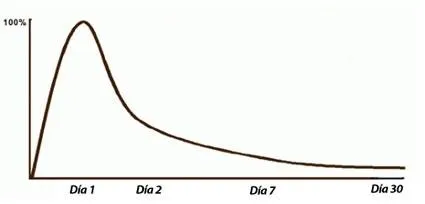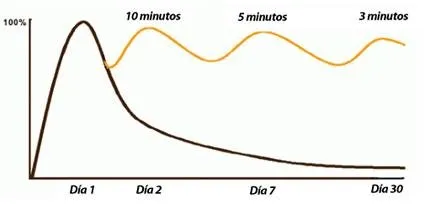Finally, you start studying. You open the book and everything seems so confusing. It is a new subject. You start reading the first paragraphs and you are already debating with a number of definitions, and as you continue reading you are trying to massively assimilate everything.
You keep reading; and then you notice you have already passed about 4 pages and quickly finished with the first topic. You feel lucky because you have advanced reading in a short time of the afternoon. You would even be able to expose what you just studied to another person.
However, as days go by you realize that all those definitions that you acquired on the day of your reading begin to disappear from your head. After a week you can hardly remember some of that difficult information. Everything has completely disappeared.

Do you find it a bit familiar?
This process is called The Forgetting Curve, known since the 19th century thanks to the study "elaborated by the German Philosopher and Psychologist Hermann Ebbinghaus in his book “Ueber das Gedächtnis” (On Memory). Even using himself as a subject of experimentation, he made the repetition of fragments of information, such as poetry and meaningless words, the basis for elaborating his theory". The Values

To avoid this type of situations it is essential to understand how The Forgetting Curve works.
The Forgetting Curve
Ebbinghaus states that if we force ourselves to memorize certain material, as time goes by, the retention of it will gradually decrease. It is what often happens with students.
"As the days pass, the material is forgotten until approximately one week after memorization". Hermann Ebbinghaus, The Values

Source
This Forgetting Curve logically has its exceptions when we acquire new information highly relevant to our brain and if it involves affective situations that cause notoriety.
Our brain collects a large amount of information continuously every day, so it must remove any information that is considered not relevant. Our responsibility will be to warn the brain about the fragments that must be retained. The ideal way to do it is through the "review".

All Ebbinghaus calculations are based on 1 hour of initial study to change The Forgetting Curve.

Source
With simple "reviews" you’ll be aware of the information learned. When doing a daily routine you will notice that every day you invest less energy and mental effort. As shown in the image above, a new yellow curve is presented in which only 10 minutes of review are used from the second day on for each hour of initial study on the first day. That is, if the first day you studied for 3 hours, the second day you do a review of 30 minutes. From seventh day on, you only use 5 minutes of review for each hour of initial study.
The pedagogical disciplines use this study and review to facilitate learning mechanisms. The Values

I recommend the use of this technique for those high school students, those who wish to successfully complete their university career, and especially those students who are learning a new language.
The repetition, review or continuous exposure to information is what will achieve the retention of new acquired material.
Post dedicated to English learners as a second language of the Loscher Ebbinghaus Institute.

